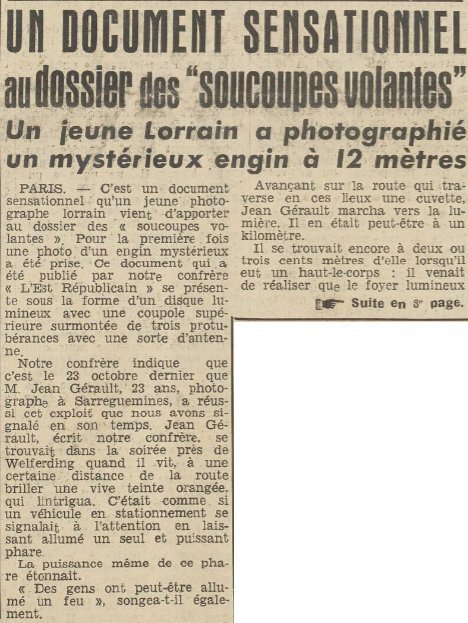The article below was published in the daily newspaper Le Courrier de Saône-et-Loire, France, pages 1 and 8, on November 4, 1954.
See the case file.

|
PARIS. -- A sensational document has just been added to the flying saucer file by a young photographer from Lorraine. For the first time, a photo of a mysterious craft has been taken. This document, published by our colleague "L'Est Républicain," shows a luminous disc with an upper dome topped by three protrusions and a sort of antenna.
Our colleague reports that it was on October 23 that Mr. Jean Gérault, 23 years old, a photographer in Sarreguemines, achieved this feat, which we reported at the time.
Jean Gérault, writes our colleague, was near Welferding in the evening when he saw, at some distance from the road, a bright orange light that caught his attention. It was as if a parked vehicle was signaling its presence by leaving a single powerful headlight on.
The sheer intensity of the light was astonishing.
"Maybe someone has lit a fire," he also thought.
Moving along the road that at this point crosses a hollow, Jean Gérault walked toward the light. He was perhaps a kilometer away.
He was still two or three hundred meters from it when he suddenly started: he had just realized that the source of the light
Continued on page 8.

|
(Continued from page 1)
was not coming from the unusual headlight of a vehicle, but from a dome whose outlines he could already clearly make out, and from which a mass with metallic reflections, dominated by the dome, was emanating. At the same time, he realized that the unknown craft was not on the road, but slightly off it, in the nearby fields.
Instinctively, he looked all around him. But no one was moving in the shadows.
LIKE AN UPSIDE-DOWN PLATE
Then he ventured forward, slipping from tree to tree along the roadside, driven by a curiosity that competed within him with fear.
He could now see the saucer very clearly. For it was indeed a saucer, of the most classic form, the one often compared to an upside-down soup plate.
Thus, heart pounding and breathing heavily, crawling partly through the ditch along the road, rising behind each tree, he managed to hide behind a trunk, about ten meters from the craft.
The craft hovered motionless, about one to one and a half meters above the neighboring field. It was resting on nothing but emitted a soft humming, like that of an electric motor running.
The lower part, with a polished metallic surface, was bordered externally by a kind of narrow metallic band, at least in appearance.
The upper part was made of a material similar to frosted glass.
A large antenna, attached to the lower part, rose prominently above the whole structure.
The entire interior of the dome was lit, and in places, the beams marked the "frosted glass" with brighter areas, as if several light sources were projecting their beams from inside toward the outside.
Due to the very nature of the dome, Jean Gérault could not distinguish anything inside.
The craft, as a whole, was perhaps five meters in diameter and two meters high.
FOUR SHOTS
In the pocket of his raincoat, he had a small camera. What professional photographer often doesn't carry his work tool with him?
It was a Kinax Junior, with a 6.3 aperture, which he had borrowed from his father while his personal camera, a Welta 6 1/2-11, was being repaired.
A Lumipan 6x9 film was loaded in the Kinax.
Despite shaking all over, Jean Gérault didn't want to miss the exceptional opportunity before him.
As best he could, judging the distance, after making sure once more that no being - human or otherwise - was moving around him, he made an approximate focus of the camera.
Fearing he wouldn't succeed with a snapshot, he braced his hand holding the Kinax against the tree trunk and took a timed exposure lasting about one second.
"At twelve meters from the saucer, shaking from head to toe, I took two shots like that... Then the camera slipped from my hands. I bent down to pick it up and took two more photos, also with timed exposure, and then, not waiting around, crouched as low as I could in the ditch, I fled backwards to about sixty meters from the craft."
OBLIQUE DEPARTURE
"I don't know why, but from that moment I became even more aware of the fear gripping me."
"From behind another tree, I then looked at the saucer a bit better than I had while photographing it."
It's in these words that Jean Gérault tells us about the most dramatic episode he experienced that Saturday evening.
Maybe a minute after he had retreated, without anything particular except an increase in the light's intensity announcing its departure, Jean suddenly saw the saucer rise obliquely into the sky, quickly pass over the nearby groves, and disappear into the low clouds ahead of him.
Our colleague refrains from drawing any conclusions from these facts or the documents he reproduces. But Lieutenant-Colonel Leroy, vice-president of the Aéro-Club of the East, commented:
"The documents just presented to me are impressive. So far, I was only aware of one serious photographic document: the one taken in the United States a few years ago. That was a group photo of craft in the air. Looking at the American document, one could think of lenticular light phenomena, often encountered in the sky. Whereas the photo presented here has much more precise and concrete material aspects. One remains perplexed before the photos that have just been shown to me."